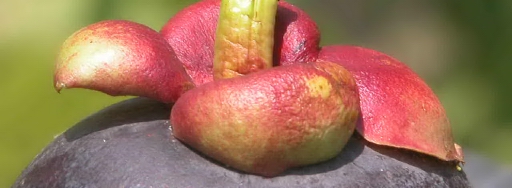
www.mangosteen.com

How to open and enjoy
Mangosteen, "the queen of fruit."
How to eat this tasty wonder
A great deal of interest has been generated in the mangosteen, also known by the scientific name, Garcinia mangostana L. This site is devoted to the understanding, appreciation, and enjoyment of the fresh mangosteen fruit. I have no commercial involvement with any of the individuals or companies who obtain or promote the mangosteen for the products resulting from processing, extracting, preserving or freezing all or part of this fruit. Any use of or links to this site to promote any mangosteen-based products that make health claims is strongly discouraged.



Enjoying the mangosteen
The mangosteen has a soft white edible center that is similar in construction to the sections of an orange, with possibly one seed in each of the larger segments. The smaller segments are seedless and seem to melt in your mouth, releasing a delicious juice that is a perfect balance of acids and sugars. The rind, or pericarp, is about 4 to 6 mm thick (1/4" or more) and when freshly harvested is somewhat soft. The fruit at that time can be opened by squeezing until the rind splits, exposing the edible segments inside.
If you have the opportunity to pick a mangosteen right off the tree the fruit is very soft, almost fragile. Using a knife simply makes the opening process neater and you are less likely to mix small pieces of the bitter rind into the delicate edible segments

Several days after harvesting, the skin begins to harden as it loses water and dries. At that point, the use of a knife is essential to open the fruit. A shallow cut around the circumference or equator of the fruit is made, trying to avoid cutting into the soft interior and then the fruit can be twisted open along the cut. For display purposes, if you cut slightly above the equator, the top with the sepals lifts off, leaving a cup filled with the white segments. These can then be scooped carefully out of the bottom or easily removed one or two at a time with a small fork. They are very slippery; expect to drop some of them if you eat enough of them! The quality inside can still be very good but the continuing hardening of the rind also increases the chances that you will injure yourself so proceed carefully. The best knife for this needs to be thin and quite sharp. Serrated edges also help.




The seeds are somewhat soft and should not be eaten as they are bitter. The mangosteen can be left at room temperature for several days as the rind will protect the interior from too much moisture loss. It may be better, however, to place the mangosteen in a refrigerator in a partially closed plastic bag to slow down moisture loss. They can also be placed without any plastic in the separately sealed compartments on the door of the refrigerator where moisture loss is somewhat impeded as well. When a mangosteen is very fresh, the seeds are white inside. As the rind hardens the seeds start to turn brown inside and this provides a rough gauge of how long the fruit has been off the tree. Some fruits will stay at room temperature for a week without any significant loss of quality. If you want to add a few days of shelf time, they should be moved in to a cooler place or refrigerator. This can add another few days. If you have your air conditioner on, the dryness of the air will speed up the hardening of the rind. Better yet, just eat them.



